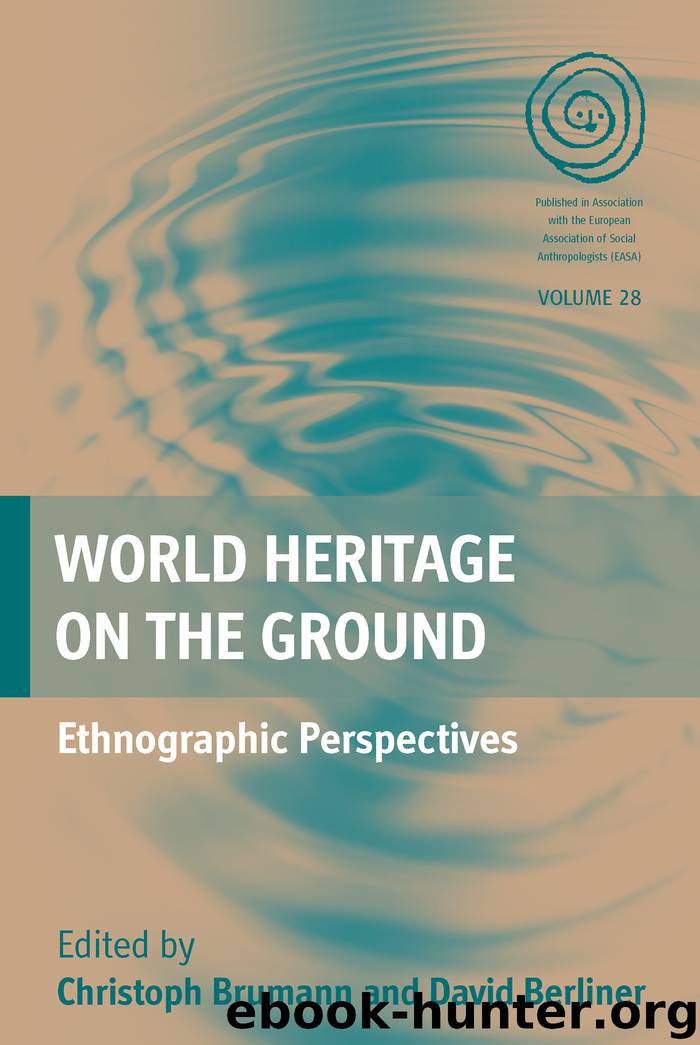World Heritage on the Ground by Brumann Christoph Berliner David & David Berliner

Author:Brumann, Christoph,Berliner, David & David Berliner
Language: eng
Format: epub
Publisher: Berghahn Books
Published: 2016-03-14T16:00:00+00:00
Conclusion
Over time, there have been remarkable shifts in the value and meaning attached to Indonesia’s cultural heritage (Salazar 2012). The postcolonial government has successfully managed to use the most iconic historical monuments within the country for tourism development, while at the same time trying to intervene in their management in the name of their preservation as part of the nation’s patrimony. These processes do not take a single course, but, rather, proceed in parallel, mutually influencing each other. The promotion of the development of national culture has been one of the most crucial tasks of the Indonesian government since independence, as is clearly stated in Article 32 of the Constitution: ‘The Government shall develop the National Culture of Indonesia.’ However, the ongoing process of political decentralization (started in 2001) is adding to the number of political actors involved and, consequently, making the management of ‘world’ heritage sites even more complex than it was before (Salazar 2010b). Initiatives such as UNESCO’s Community Empowerment through Heritage Education programme at Indonesia’s cultural World Heritage sites try to involve local communities more actively as stakeholders.
Increased scholarly attention is needed to address the fact that World Heritage sites, despite their proclaimed universal value, have different meanings for different groups of actors (Salazar 2012). Traditionally, values were articulated by expert analyses of heritage as a work of art or a record of the past. Only recently has the heritage field begun to embrace such factors as economics, cultural change, public policy and social issues. The advantage of an ethnographic approach in this aperture is that it can focus on the way values function in everyday life and in particular on the deliberations in which they are formed and expressed. Despite their proclaimed universal value, my findings clearly illustrate that World Heritage sites, even neighbouring ones, have different values and meanings for different groups of actors at local, national and global levels. This is only partly based on the nature of the sites and points to the importance of historical contingency. An in-depth analysis of the empirical findings leads to a broader reflection on the dynamic interplay between the externally imaged (represented) and locally imagined value and management of World Heritage in Indonesia and beyond. It shows how heritage is always enmeshed in complex webs of meaning, variously cherished and expressed by actors at different levels.
The case study presented in this chapter confirms the importance of in-depth research in disentangling the complex dynamics of ‘world heritage’. The study of Central Java’s cultural history shows how outsiders have set the agenda since the time heritage became an issue of importance: Dutch and British colonials, the central government in Jakarta and UNESCO, ICOMOS and other international organizations. Such growing translocal interdependence is irreversible but variously received. We should be wary of attaching too much agency to the designation of World Heritage. The example of Prambanan teaches us how, in times of change, the local meaning of heritage can change too. The global recognition by UNESCO, for instance, is used
Download
This site does not store any files on its server. We only index and link to content provided by other sites. Please contact the content providers to delete copyright contents if any and email us, we'll remove relevant links or contents immediately.
The Secret History by Donna Tartt(16617)
The Social Justice Warrior Handbook by Lisa De Pasquale(11489)
Thirteen Reasons Why by Jay Asher(7786)
This Is How You Lose Her by Junot Diaz(5764)
Weapons of Math Destruction by Cathy O'Neil(5034)
Zero to One by Peter Thiel(4823)
The Myth of the Strong Leader by Archie Brown(4789)
Promise Me, Dad by Joe Biden(4444)
Stone's Rules by Roger Stone(4415)
Beartown by Fredrik Backman(4412)
How Democracies Die by Steven Levitsky & Daniel Ziblatt(4396)
The Fire Next Time by James Baldwin(4340)
100 Deadly Skills by Clint Emerson(4075)
A Higher Loyalty: Truth, Lies, and Leadership by James Comey(4031)
Rise and Kill First by Ronen Bergman(4012)
The David Icke Guide to the Global Conspiracy (and how to end it) by David Icke(3880)
The Farm by Tom Rob Smith(3871)
Secrecy World by Jake Bernstein(3782)
The Doomsday Machine by Daniel Ellsberg(3730)
